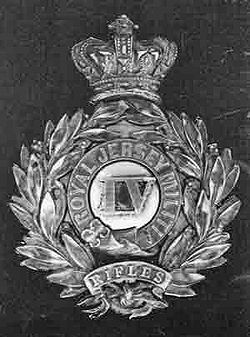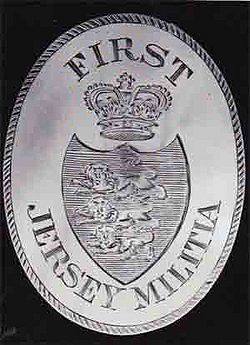From Jerripedia

An interesting silver shoulder-belt plate in the author's collection. This officer's plate of the 3rd or East Regiment, is rectangular, 3½ x 3 inches, and was hallmarked in 1827. It has a crown superimposed on the plate and beneath it a garter on which are the words 'Jersey Royal Militia'. This device is unusual because it is of the later pattern, c1845, and it is assumed that an officer of many years service, rather than scrap his old plate, had the later device fitted to it. There is a small hole in the back-plate that would seem to confirm this. The other fittings are a wreath of laurel leaves and, in the centre, a large 3. The silver marks are the lion, the King's head, the letter 'rri', the London mark and the maker's mark, MR/CR the mark of Mary and Charles Reily. On the reverse is a backing of soft leather, and the prongs and studs for attaching the plate to the belt.

A shoulder-belt plate from the author's collection. It is a 4th or Saint Lawrence Battalion plate. It is hallmarked London 1827, the maker's mark is MR/CR for Mary and Charles Reily. The plate is rectangular, and is 3 x 3¾ inches. The reverse has its original leather backing. It was worn by John Pinel who was in the Royal Jersey Militia for many years.

Another shoulder-belt plate in the collection of La
Société Jersiaise. This is an artillery plate of the late 18th century, and is a small rectangle, 1½ x 2¾ inches, made of brass with a gilded finish. It has the three leopards of Jersey engraved on an oval, above which is the word 'Jersey' surmounted by a Georgian crown. Surrounding the oval is a stand of arms and on either side of the crown are the initials 'R' and 'A'. It has a line groove edge. When first seen by the author this plate was attached to a buckskin cross belt and had its correct sword, a 1776 pattern hanger, in its proper scabbard. All these items were in good condition and all were of the same period.

A shoulder-belt plate of unknown date. Unlike the other officers' plates which were abolished in 1855, those of the Rifles continued to be worn for some time and the only indication of date is that the IVth Regiment ceased to exist after 1878 when the Militia was reformed. The five regiments were reduced to three; the IVth Regiment, the Saint Helier or Town Battalion, and the Saint Lawrence Battalion became the South Regiment. The plate is a wreath of laurel leaves below a crown. This surrounds a garter with the words 'Royal Jersey Militia' and below is a scroll with the single word 'Rifles'. In the centre is 'IV'. The plate is 3½ x 2¾ inches and is not hallmarked. On the reverse are four lugs for attaching it to the belt.

A shoulder-belt plate of the late 18th century. This officer's plate, a silver oval, 2½ x 3½ inches, has no hall¬mark or maker's mark but its date would be c17S0. In the centre is a crown and beneath it a shield on which are the three leopards of Jersey. Above the crown is the word 'First' and below the shield 'Jersey Militia'. The device is engraved as is the line groove around the oval. The plate is slightly convex

A very fine officer's plate in the collection of the
Société Jersiaise. It is a silver oval 2 x 2½ inches. The three leopards of Jersey are engraved on a shield below a crown, the whole being surrounded by a garter. Engraved on the garter are the words East . or . Third . Regiment . Jersey Militia. On the reverse of the plate, are the initials 'J Q' for Jacques Quesnel, who made it in the last quarter of the 18th century, and 'E V D', possibly the man for whom the plate was made.

A silver shoulder-belt plate of the 4th or Saint Lawrence Battalion. The plate is 3 x 3¾ inches and is rectangular and convex. It was made by Joseph Jenner and Co. of Birmingham and was hallmarked in 1845. It has a crown over a garter on which are the words 'Jersey Royal Militia'. In the centre is a large '4', and a wreath of laurel leaves surrounds the whole. On the reverse of the plate are two prongs and two studs for attaching it to the belt and there is a chamois leather backing.

A very fine plate of the 1st or North-West Regiment. It is a silver rectangle, 3½ x 3 inches, and although it has no hallmark, its date would be cl830. The device on the plate is a crown with a number '1' beneath it and beneath this again a garter with the words 'Royal Jersey Reg". Inside the garter are the three leopards of Jersey. A wreath of laurel leaves surrounds the whole. All parts of the device are fitted through the plate and are pinned on from the back. On the reverse are two prongs and two studs for fixing it to the belt. There is also a leather backing.
Shoulder-belt plates, as part of British military uniforms, were a development of the plain buckle that was worn on the cross belt. According to Major R G Parkyn, author of Shoulder-Belt Plates and Buttons (1956), the first plates appeared about 1774 and were worn by both officers and other ranks. The officers wore a cross belt over the right shoulder to carry the sword, other ranks had two belts, joined in the centre by the belt plate, to carry their equipment.
Many of the officers' plates were silver, silver-plated or gilt, depending on the facing and lace on the uniform. Some were convex and of oval shape, some were rectangular and flat, but all tended to be small. The other ranks' plates were of brass or copper, cast or die-struck, very often engraved with only a cypher or number. As this makes them difficult to identify I will concentrate only on officers' plates.
After 1800 plates tended to become larger and more ornate. The rectangular plate became universal with the device superimposed on the silver or gilt back-plate. It is not always possible to be precise with dates as more often than not the plates were not hallmarked, only the few that were give us an indication of the changes in pattern.
Militia
In 1774 the Jersey Militia consisted of five regiments and the Royal Jersey Artillery. The Artillery had been made Royal in 1771 but the five regiments had to wait for this honour until 1831.
The regiments were:-
- 1st North-West - Saint Ouen, Saint John and Saint Mary.
- 2nd North - Saint Martin and Trinity.
- 3rd East - Saint Saviour, Grouville and Saint Clement.
- 4th (IV) South - Two battalions, Saint Lawrence and Saint Helier.
- 5th South-West - Saint Brelade and Saint Peter.
The Saint Lawrence Battalion of the South Regiment used the number 4 and that of Saint Helier or Town Battalion the Roman numeral IV.
One of the earliest plates I have seen is of the 1st Regiment; it is quite small, 2½ x 3½ inches, and is a silver oval with an engraved design. This one is in a private collection but there is a similar plate at Castle Cornet in Guernsey.
The Société Jersiaise has two early plates in its collection. One is the fine example by Jacques Quesnel, and is of the 3rd Regiment; the other is of the Royal Jersey Artillery.
Plates traced
Below is a list of the plates I have been able to trace:-
- 1st Regiment, c1780 - private collection
- 2nd Regiment, c1780 - private collection
- 3rd Regiment, Jacques Quesnel - Societe Jersiaise
- 1st Regiment, c1780 - Castle Cornet
- Royal Jersey Artillery, 1775 - Societe Jersiaise
- Royal Jersey Artillery, 1775 - Elizabeth Castle
- 1st Regiment, c1827 - Private collection
- 2nd Regiment, c1845 - Elizabeth Castle
- 3rd Regiment, c1845 - private collection
- 3rd Regiment, hallmarked 1827 - private collection
- 4th Regiment, hallmarked 1827 - private collection
- 4th Regiment, hallmarked 1845 - Private collection
- 4th Regiment, c1845 - Societe Jersiaise
- 4th Regiment, c1845 - private collection
- 4th Regiment, c1845 - Castle Cornet
- 4th Regiment, c1845 - Castle Cornet
- 4th Regiment, c1845 - Castle Cornet
- IVth Regiment, c1850 - Castle Cornet
- 5th Regiment, c1845 – Castle Corner
- IVth Regiment Rifles, c1850 – private collection
There is also a silver engraved oval plate with no regimental title, c1780, in a private collection.
In 1855 the shoulder-belt plate was abolished and the cross belt was replaced by a waist-belt. The exceptions to this were the Rifles and Scottish Regiments in the United Kingdom. In some cases their plates are worn to this day.

An officer in the 4th St Lawrence Battalion. The design on the shoulder belt plate is the crown over the garter on which are the words Jersey Royal Militia, this being the form of inscription found on later plates. Surrounding the garter is a wreath of laurel leaves, and in the centre is a large '4'. The painting, from the collection of La
Société Jersiaise is signed by T Seed and is dated 1838










